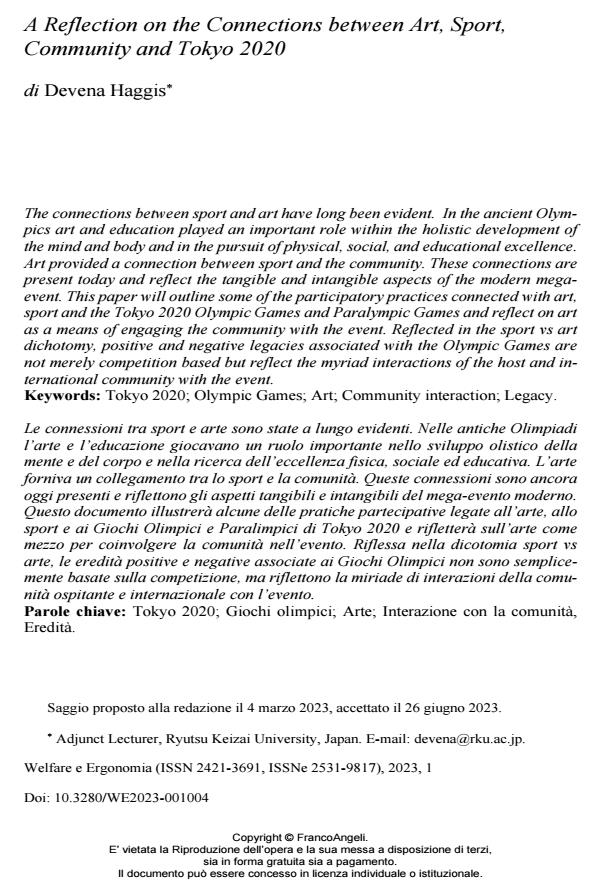A Reflection on the Connections between Art, Sport, Community and Tokyo 2020
Titolo Rivista WELFARE E ERGONOMIA
Autori/Curatori Devena Haggis
Anno di pubblicazione 2023 Fascicolo 2023/1
Lingua Inglese Numero pagine 19 P. 39-57 Dimensione file 649 KB
DOI 10.3280/WE2023-001004
Il DOI è il codice a barre della proprietà intellettuale: per saperne di più
clicca qui
Qui sotto puoi vedere in anteprima la prima pagina di questo articolo.
Se questo articolo ti interessa, lo puoi acquistare (e scaricare in formato pdf) seguendo le facili indicazioni per acquistare il download credit. Acquista Download Credits per scaricare questo Articolo in formato PDF

FrancoAngeli è membro della Publishers International Linking Association, Inc (PILA)associazione indipendente e non profit per facilitare (attraverso i servizi tecnologici implementati da CrossRef.org) l’accesso degli studiosi ai contenuti digitali nelle pubblicazioni professionali e scientifiche
The connections between sport and art have long been evident. In the ancient Olympics art and education played an important role within the holistic development of the mind and body and in the pursuit of physical, social, and educa-tional excellence. Art provided a connection between sport and the community. These connections are present today and reflect the tangible and intangible as-pects of the modern mega-event. This paper will outline some of the participatory practices connected with art, sport and the Tokyo 2020 Olympic Games and Para-lympic Games and reflect on art as a means of engaging the community with the event. Reflected in the sport vs art dichotomy, positive and negative legacies as-sociated with the Olympic Games are not merely competition based but reflect the myriad interactions of the host and international community with the event.
Le connessioni tra sport e arte sono state a lungo evidenti. Nelle antiche Olim-piadi l’arte e l’educazione giocavano un ruolo importante nello sviluppo olistico della mente e del corpo e nella ricerca dell’eccellenza fisica, sociale ed educati-va. L’arte forniva un collegamento tra lo sport e la comunità. Queste connessioni sono ancora oggi presenti e riflettono gli aspetti tangibili e intangibili del mega-evento moderno. Questo documento illustrerà alcune delle pratiche partecipative legate all’arte, allo sport e ai Giochi Olimpici e Paralimpici di Tokyo 2020 e ri-fletterà sull’arte come mezzo per coinvolgere la comunità nell’evento. Riflessa nella dicotomia sport vs arte, le eredità positive e negative associate ai Giochi Olimpici non sono semplicemente basate sulla competizione, ma riflettono la mi-riade di interazioni della comunità ospitante e internazionale con l’evento.
Parole chiave:Tokyo 2020; Giochi olimpici; Arte; Interazione con la comunità, Eredità.
- Youth Policy, Citizenship Education and Olympic Games Legacies Sandra Borges Tavares, pp.123 (ISBN:978-981-99-6578-6)
Devena Haggis, A Reflection on the Connections between Art, Sport, Community and Tokyo 2020 in "WELFARE E ERGONOMIA" 1/2023, pp 39-57, DOI: 10.3280/WE2023-001004